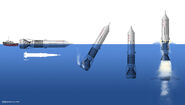The Sea Dragon is a two-staged sea-launched super heavy-lift launch vehicle built by NASA and first launched from the South Pacific ocean on its maiden flight in 1977.[1]
General information[]
At 150 m (490 ft) long [note 2] and 23 m (75 ft) in diameter, Sea Dragon is the largest rocket ever built and can carry 550 metric tons of payload into low Earth orbitW. It is also large enough to fit almost all of the Saturn V into its first stage. The Sea Dragon appears to have a crew capsule on the top, however, this has never been used and no crew have ever been launched on the vehicle.
Four Sea Dragons have been built by 1995, with 3 of them still in use. The first one was destroyed in 1983.
History[]
Sea Dragon's first mission in 1977 was used to supply the lunar Jamestown base with hundreds of tons of building materials, fuel, and equipment.[1]
On mission 16 in 1983, components for a plutonium fueled nuclear power-source were delivered, in an effort to cut the costs of living on the Moon.[2]
In fall 1983, during a standoff with the Soviet shuttle Buran, Ed Baldwin launched missiles toward Sea Dragon 17 to prevent further escalation. NASA covered it up as a malfunction and further Sea Dragon production was halted until further investigation as a result.[3] Production and missions have been continued at some later date.
In the 90s, the Sea Dragon was used to ship Sojourner 1 components to the Moon, which were then tested and assembled at NASA's facilities around the Jamestown base. New Jamestown modules were planned to be shipped there in September 1992.[4] In 1995, components for Sojourner 2 were delivered to the Moon.[5]
Sea Dragon missions[]
| Mission / Designator | Vehicle | ID | Mission | Date | |
|---|---|---|---|---|---|
| Sea Dragon 1 | SD-1 | Jamestown supply run (Building supplies, fuel, equipment) |
1977 | ||
| Sea Dragon 16 | SD-16 | Jamestown supply run (Nuclear fuel & 2nd reactor) |
August 1983 | ||
| Sea Dragon 17 | SD-17 | Jamestown supply run | Sept. 1983 | ||
| Sea Dragon 38 [6] | SD-38 | Sea Dragon 2 | LV-2 | Supply run | August 1992 |
| Sea Dragon 39 [7] | SD-39 | Sea Dragon 3 | LV-3 | Supply run | August 1992 |
| New Jamestown modules | September 1992 (planned) [4] | ||||
| Sea Dragon 46 [5] | SD-46 | Sea Dragon 4 | LV-4 | Sojourner-2 components | March 1995 |
| Sea Dragon 47 | SD-47 | Sea Dragon 4[8] Sea Dragon 3[9] |
LV-4B LV-3 |
DOD (classified) Supply run |
Mid 1995 [note 3] |
| Sea Dragon 48 [8] | SD-48 | Sea Dragon 3 | LV-3 | Jamestown logistics | Mid 1995 |
Galleries[]
Sea Dragon 1[]
Sea Dragon 16[]
Sea Dragon 17[]
Comparisons[]
Notes[]
- ↑ 1.0 1.1 Technical data from the real world concept.
- ↑ 2.0 2.1 2.2 There is a problem between what is said and what is shown in the Apple+ bonus video. In the newscast, they show a graphic saying the height is 545 ft (166 m), while at the same time the news anchor tells it's 490 ft.
490 ft (150 m) is what the real-life concept of the Sea Dragon was. - ↑ There is a discrepancy with this mission. The mission status boards seen in the episodes 3x06 and 3x07 tell different things about the mission and the vehicle used for SD-47.
Trivia[]
- The Sea Dragon was designed in 1962 by Robert Truax to serve as a low-cost heavy launcher, commonly known as a "big dumb booster". NASA and Todd Shipyards started showing interest in this project.
- To keep costs low, Sea Dragon was designed to be built from inexpensive sheet steel, launched from the ocean to reduce launch infrastructure, and operate using simple, reliable engineering principles.
- The rocket was partially reusable, as the first stage engine could be recovered after each flight.
- It was to be fueled using hydrogen produced from the surrounding sea water via electrolysis generated from the nuclear reactor of a nearby aircraft carrier. (Hence the "Carrier task force" Ed mentions in 1983). While RP1 is loaded from the seaside.
- It remains the largest rocket ever launched.
- Sea Dragon is built in a shipping yard and then shipped through the Panama Canal. It takes 4.7 weeks for the rocket to be transported to the area it is refueled (sometimes it would be refueled at the launch site), then another week to get to its launch destination. Sometimes, the rocket would be put at the launch site and the cargo would be put in. They were able to do this because they just adjusted the buoyancy tanks and that would allow the rocket to come out of the water more so they would then remove the fairings and put the payload in and then put the fairings back on and Sea Dragon would be ready for launch.
- There have been over 30 Sea Dragon missions since Sea Dragon 17 in 1983, with the most recent known mission being Sea Dragon 48 in mid 1995.
See also[]
External links[]
 Sea Dragon on Wikipedia
Sea Dragon on Wikipedia Sea Dragon launch on YouTube (1x10 post credit scene)
Sea Dragon launch on YouTube (1x10 post credit scene) Matthew Cable: Sea Dragon - KSP Cinematic on YouTube (1x10 post credit scene done in KSP)
Matthew Cable: Sea Dragon - KSP Cinematic on YouTube (1x10 post credit scene done in KSP) Primal Space: The Largest Rocket Never Launched on YouTube
Primal Space: The Largest Rocket Never Launched on YouTube
References[]
- ↑ 1.0 1.1 Bonus Video: One Giant Leap: 1975-1982 - Sea Dragon Launch (1977)
- ↑ For All Mankind TV Series - Season 2, Episode 6: "Best Laid Plans"
- ↑ For All Mankind TV Series - Season 2, Episode 10: "The Grey"
- ↑ 4.0 4.1 For All Mankind TV Series - Season 3, Episode 3: "All In"
- ↑ 5.0 5.1 Season 3, Episode 7: "Bring It Down" (Mission status board @ 43:00) → Screenshot
- ↑ Season 3, Episode 2: "Game Changer" (Mission status board @ 57:45) → Screenshot
- ↑ Season 3, Episode 2: "Game Changer" (Mission status board @ 07:47) → Screenshot
- ↑ 8.0 8.1 Season 3, Episode 6: "New Eden" (Mission status board @ 44:25) → Screenshot
- ↑ Season 3, Episode 7: "Bring It Down" (Mission status board @ 43:03) → Screenshot





















![FAM Bonus 1975-1982 05.41 News - Sea Dragon comparison closeup.png (168 KB) Comparison shown in TV news [note 2]](https://static.wikia.nocookie.net/for-all-mankind/images/a/ab/FAM_Bonus_1975-1982_05.41_News_-_Sea_Dragon_comparison_closeup.png/revision/latest/scale-to-width-down/185?cb=20221026103733)



